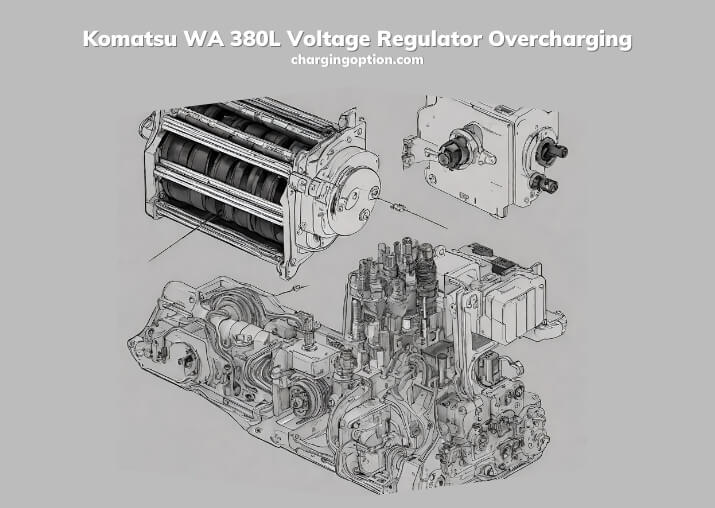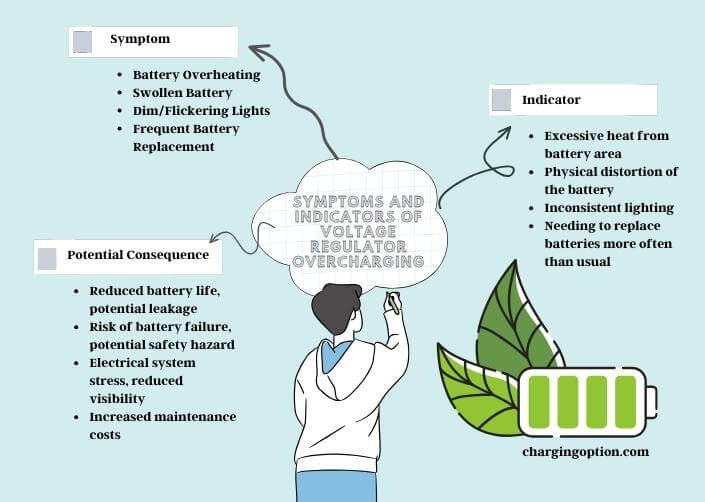The Komatsu WA 380L external voltage regulator may cause overcharging due to malfunction or incorrect settings. This issue can lead to battery damage and affect the loader’s electrical system.
Komatsu’s WA 380L is a robust wheel loader known for its efficiency and reliability in heavy-duty operations. An integral part of its electrical system is the external voltage regulator, designed to maintain a consistent voltage level. This component is crucial for the health of the battery and the overall electrical system. Overcharging occurs when the regulator fails to limit the voltage supplied to the battery, leading to excessive charge levels.

Several factors can contribute to this problem. A common cause is a malfunction within the regulator itself, where internal components like diodes or resistors fail, disrupting its ability to control voltage. Another possibility is incorrect calibration or settings, which can happen during maintenance or replacement of the regulator. This misalignment leads to higher voltage output than necessary.
The consequences of overcharging are significant. It can shorten the battery’s lifespan by causing it to overheat and degrade. Other electrical components, such as the alternator and electronic control units, may suffer damage due to the excessive voltage. Regular maintenance and timely checks of the voltage regulator are essential to prevent these issues.
For those facing overcharging issues with their Komatsu WA 380L, understanding the role and potential problems of the external voltage regulator is key. Addressing this issue promptly ensures the longevity and efficient operation of the loader. For a more detailed analysis and solutions, read the full article below.
Komatsu WA 380L Voltage Regulator Overcharging: Insights & Fixes
The Role of Komatsu WA 380L’s External Voltage Regulator
Basic Functions in the Loader’s Electrical System
The external voltage regulator in the Komatsu WA 380L plays a pivotal role in its electrical system. It’s like the guardian of the electrical flow, ensuring that the battery receives the right amount of voltage. Without it, the battery could get too much power, leading to overcharging, or too little, resulting in undercharging. Both scenarios are bad news for the loader’s health. This regulator keeps everything in balance, much like a thermostat maintains a home’s temperature.
Design and Working Principles
Understanding the design and working principles of this regulator is key. It’s not just a box attached to the engine; it’s a sophisticated piece of technology. Inside, there are components like diodes and resistors that work together to monitor and adjust the voltage. Think of it as a smart device that constantly checks and balances the power supply, ensuring your loader’s battery is in top shape.
Detecting Overcharging in the WA 380L
Symptoms and Signs of Overcharging
Spotting overcharging in your Komatsu WA 380L isn’t rocket science. You’ll notice signs like the battery getting too hot or swelling up. It’s like when your smartphone overheats – it’s a clear signal something’s not right. Also, if you’re seeing dim or flickering lights on the loader, that’s another red flag. These symptoms are your loader’s way of crying out for help.
Consequences for Battery and Electrical Components
The consequences of overcharging are serious. It’s not just about replacing a battery more often. Overcharging can damage the entire electrical system of your loader. Think of it as a domino effect; once the battery goes haywire, it’s only a matter of time before other components start to suffer. This can lead to costly repairs and downtime, which no one wants.
Symptoms and Indicators of Voltage Regulator Overcharging
| Symptom | Indicator | Potential Consequence |
| Battery Overheating | Excessive heat from battery area | Reduced battery life, potential leakage |
| Swollen Battery | Physical distortion of the battery | Risk of battery failure, potential safety hazard |
| Dim/Flickering Lights | Inconsistent lighting | Electrical system stress, reduced visibility |
| Frequent Battery Replacement | Needing to replace batteries more often than usual | Increased maintenance costs |

Investigating Causes of Overcharging
Failures in Internal Components
The internal components of the voltage regulator are like the internal organs of a human body. When something goes wrong inside, it affects the whole system. In the case of your Komatsu WA 380L, a failure in these components means the regulator can’t do its job properly. It’s like having a broken thermostat in your house; the temperature goes haywire.
Errors in Calibration and Settings
Sometimes, the issue isn’t a broken part but a misconfiguration. If the regulator’s settings are off, it’s like having a badly tuned instrument in an orchestra – everything is out of sync. This misalignment can cause the regulator to send too much power to the battery, leading to overcharging.
Environmental Factors and Their Effects
Don’t forget about the environment around your loader. Extreme temperatures, dust, and moisture can all mess with the voltage regulator. It’s like trying to use your phone in a sandstorm; it’s not going to work well. These conditions can cause the regulator to malfunction, leading to overcharging.
Frequency and Types of Overcharging Causes
| Cause Type | Frequency | Notes |
| Component Failure | Common | Often due to wear and tear |
| Calibration Error | Less Common | Usually a result of improper maintenance |
| Environmental Factors | Variable | Depends on operating conditions |
Maintenance Strategies to Prevent Overcharging
Routine Inspection and Testing Procedures
Regular check-ups are essential for preventing overcharging. It’s like going to the doctor for a regular health check. You need to inspect the voltage regulator and the battery to catch any early signs of trouble. Testing the system’s voltage output regularly is also crucial. This proactive approach can save you a lot of headaches down the road.
Best Practices for Maintaining Voltage Regulators
The best practices for maintaining your voltage regulator are simple yet effective. Keep it clean and free from debris – think of it as keeping your workspace tidy. Also, ensure that all connections are secure and corrosion-free. It’s like making sure all the wires in your home entertainment system are properly plugged in for the best experience.
Diagnosing Overcharging Problems

Stepwise Guide for Problem Identification
Diagnosing overcharging issues in your Komatsu WA 380L is a step-by-step process. First, check the battery’s condition. Is it overheating? Swollen? Next, test the voltage output. If it’s too high, that’s a clear sign of trouble. Then, inspect the regulator itself. Are there any visible damages or loose connections? This methodical approach will help you pinpoint the problem.
Guidelines for Seeking Professional Assistance
Sometimes, it’s best to call in the pros. If you’ve gone through the basic checks and things still aren’t right, don’t hesitate to seek professional help. It’s like when your car’s making a weird noise – you take it to a mechanic. A skilled technician can diagnose and fix the issue much faster, getting your loader back in action.
Troubleshooting Steps and Their Effectiveness
| Troubleshooting Step | Effectiveness | Notes |
| Battery Condition Check | High | Easy to observe physical symptoms |
| Voltage Output Test | High | Requires a multimeter but is very telling |
| Regulator Inspection | Medium | Some issues may not be visibly apparent |
Repair and Replacement Solutions
Tips for Do-It-Yourself Repairs
If you’re handy and feel confident, tackling minor repairs yourself can be a cost-effective solution. It’s like fixing a leaky faucet at home. Sometimes, it’s as simple as tightening a connection or cleaning off some corrosion. Just make sure you have the right tools and knowledge before diving in.
Selecting Appropriate Replacement Parts
Choosing the right replacement parts is crucial. It’s like picking the right ingredients for a recipe – the quality matters. Go for OEM (Original Equipment Manufacturer) parts when possible. They’re designed specifically for your loader model, ensuring a perfect fit and optimal performance.
Services for Professional Repairs
When in doubt, professional repair services are your best bet. They have the expertise and equipment to handle complex issues. It’s like going to a specialist for a medical condition – they know exactly what to do. Plus, they can often provide warranties on their work, giving you peace of mind.
The Effect of Overcharging on Loader Performance
Immediate and Long-Term Impacts on Efficiency
The immediate effects of overcharging can be quite noticeable – reduced battery life, poor electrical performance, and even safety hazards. But the long-term impacts are even more significant. Consistent overcharging can lead to chronic issues in your loader, reducing its overall efficiency and lifespan. It’s like eating junk food every day – it might not hurt you right away, but over time, it takes a toll on your health.
Financial Consequences of Neglecting Overcharging
Ignoring overcharging issues can hit your wallet hard. The cost of frequent battery replacements, potential damage to other electrical components, and downtime can all add up. It’s like ignoring a small leak in your roof – eventually, it leads to a much bigger, more expensive problem.
In summary, keeping an eye on your Komatsu WA 380L’s voltage regulator is key to preventing overcharging issues. Regular maintenance, being aware of the symptoms, and knowing when to seek professional help can save you from a lot of trouble. Remember, taking care of your loader’s electrical system is an investment in its longevity and performance.
